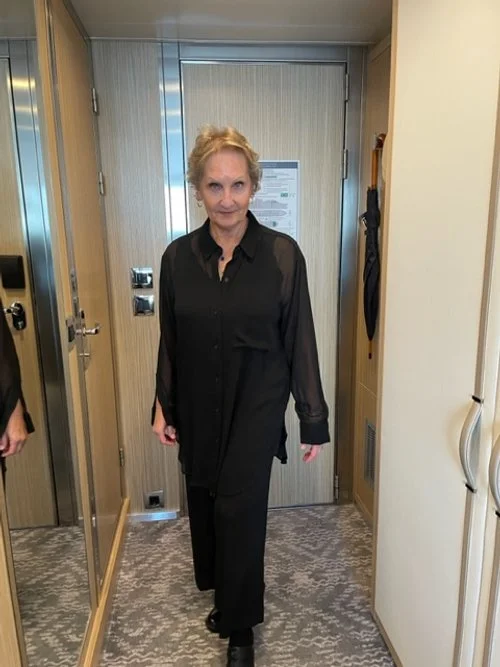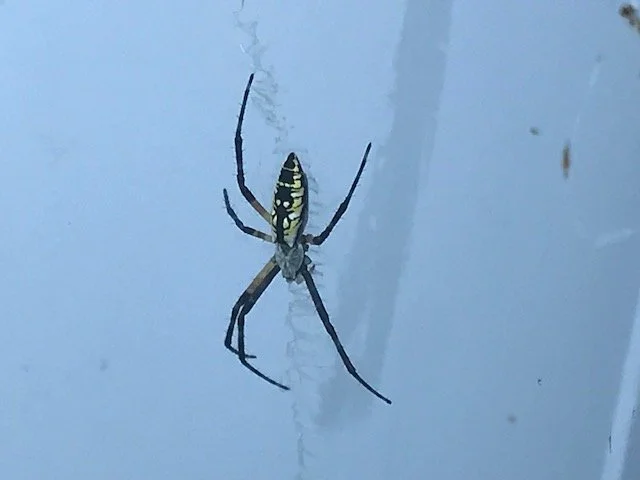The people who have early flights from Iceland are dropped off at the airport, and those of us who will depart later are loaded on to a bus for a final excursion. First stop, the Viking Museum, where we’re to spend forty-five minutes. Though I’m certain it’ll be boring, it turns out that there’s one thing kind of cool about it, which is that a longship is suspended from the ceiling. Access is on the second floor, so I go on up, clamber into it, and spend a delightful five minutes fantasizing that I’m a conquering Viking. To my surprise, no one else seems interested in exploring the boat.
As I’m walking down the stairs, I meet a woman ascending.
“The ship’s kind of fun,” I tell her.
“Oh honey,” she responds. “It’s scrawny compared to the one I saw in Norway.”
Her tone is uppity. She’s doing that thing tourists do where they show off how much they’ve traveled, and prattle on about what they saw in which country. David and I learned long ago not to enter into these competitions—the same way we learned not to discuss our brilliant children with the parents of other kids. Other people simply can’t top us, and there’s no joy in pointing it out.
When we return to the bus we’re told that we’ll be traveling ninety minutes to see a geyser. A few people behind me moan. We’ve seen plenty of geysers. This is the second day of a miserable cold for me, and as soon as the engine roars to life I shut my eyes, planning to catch a nap. But the woman in front of me starts sharing her thoughts with her husband. I admire the way she talks, low-pitched and slow as syrup—Alabama is my guess.
“Home tonight,” she says. Then again, “Home tonight. I want my bed. Oh, I want my bed. And then tomorrow I’ve got to get groceries and pick up Baby from Barkingham Palace. Groceries and Baby. Barkingham Palace. I signed her up for a bath and she’ll be soft and clean. This was a good trip. Oh, the food was so good. That’s what I look forward to when we take a cruise—the good food.”
Throughout this there is no response from the husband. She continues.
“And then day after tomorrow I’ve got that dental appointment. For a cleaning. A cleaning. I hope I get that other gal this time. She was nice. The last one was harsh with the floss. Harsh. I need to call Millie May about that book. Oh, that book. She wants to recommend it for our book group but I don’t know if it’s too controversial. There’s so much political turmoil these days. So much political turmoil.”
She’s incessant. She drones on as I lean my head against the window and fall asleep. She’s still talking when, an hour later, we roll to a stop.
It looks like David also had a snooze. As he’s coming awake, I lean toward him and ask in a whisper—Have you been listening to this woman? His response: I’ve been trying not to.
Some people get off to go look at yet another eruption, and some stay put. I elect to remain, as does the couple in front.
“You need to get off and go to the restroom,” the woman tells her husband, who obediently rises, dons his coat, and shuffles toward the exit. Then, though he’s gone, she continues her monologue.
“Where is it?” she asks as she lifts herself taller so she can view her husband as he walks away. “Where’s the men’s? There it is. A line. Oh, a long line. Get in the line! Go ahead! Okay, he’s in line. All these buses. All these buses. No wonder there’re so many in the line. I don’t know about that book Minnie May suggested. Maybe I’ll talk to Carla about. Has Carla read it? I don’t know. I don’t know. What’s he doing? He’s getting out of the line! No. Get back in line! He’s coming back.”
Pretty soon he appears in the doorway and makes his way back to his seat, but she won’t let him claim it.
“What are you doing? Why did you get out of line? You need to go to the restroom. Oh, you need to go. Go. Get back in the line.”
With a shrug, he turns away. Once again, she watches him leave, then keeps watch.
“Good. That’s good. Get in the line.”
Later, as we’re heading back to Reykjavik, we pass a grocery store with a dancing pig on the front. The woman says, “Dancing pig. Dancing pig.”
At the airport, as we’re waiting to hand over our baggage, I give her repetitive way of speaking a try.
“Icelandair,” I say, then again, “Icelandair.” Then, “American Airlines. American Airlines.”
The repetition is bizarrely comforting and, even more bizarrely, addicting.
“Stop it,” I say. “Stop it.”
In our cabin on one of the dressy evenings.
Another one of the many beautiful faces of Iceland.












